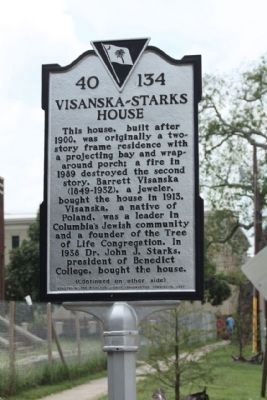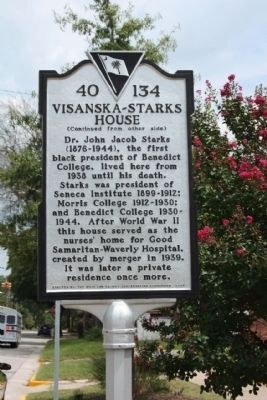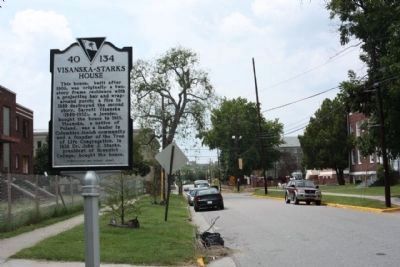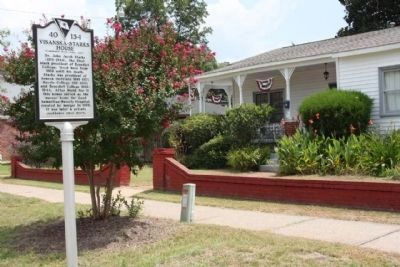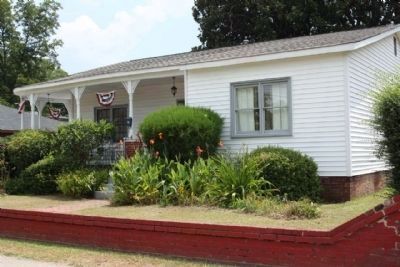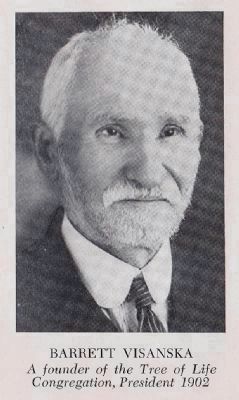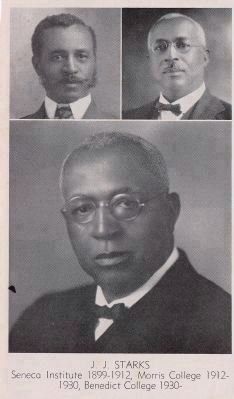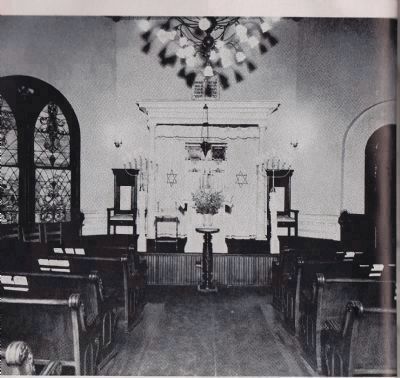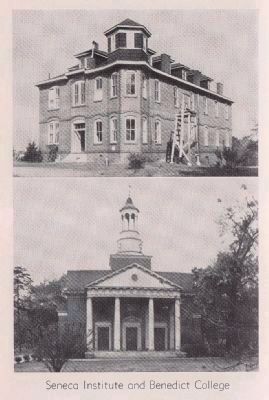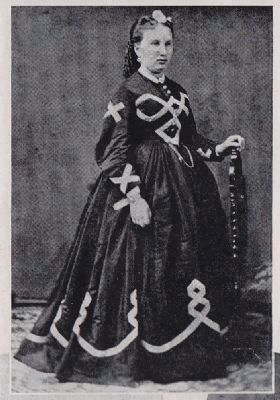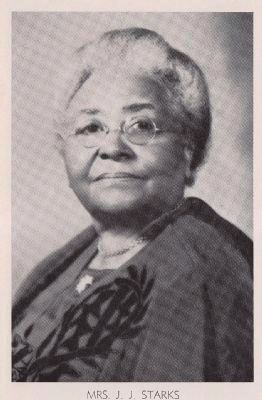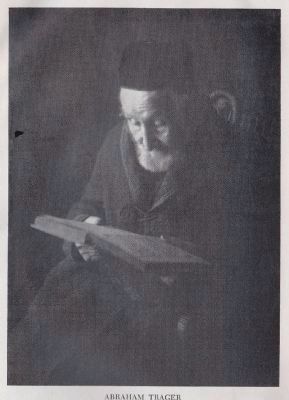Waverly in Columbia in Richland County, South Carolina — The American South (South Atlantic)
Visanska-Starks House
This house, built after 1900, was originally a two-story frame residence with a projecting bay and wraparound porch; a fire in 1989 destroyed the second story. Barrett Visanska (1849-1932), a jeweler, bought the house in 1913. Visanska, a native of Poland, was a leader in Columbia’s Jewish community and a founder of the Tree of Life Congregation. In 1938 Dr. John J. Starks, president of Benedict College, bought the house.
(Reverse text)
Dr. John Jacob Starks (1876-1944), the first black president of Benedict College, lived here from 1938 until his death. Starks was president of Seneca Institute 1899-1912; Morris College 1912-1930; and Benedict College 1930-1944. After World War II this house served as the nurses’ home for Good Samaritan-Waverly Hospital, created by merger in 1939. It was later a private residence once more.
Erected 2007 by Richland County Conservation Commission. (Marker Number 40-134.)
Topics and series. This historical marker is listed in these topic lists: African Americans • Civil Rights • War, US Civil. In addition, it is included in the Historically Black Colleges and Universities series list. A significant historical year for this entry is 1900.
Location. 34° 0.633′ N, 81° 1.105′ W. Marker is in Columbia, South Carolina, in Richland County. It is in Waverly. Marker is on Hampton Street, on the right when traveling east. Located between Pine and Oak Streets. Touch for map. Marker is at or near this postal address: 2214 Hampton Street, Columbia SC 29204, United States of America. Touch for directions.
Other nearby markers. At least 8 other markers are within walking distance of this marker. Cyril O. Spann Medical Office (within shouting distance of this marker); Good Samaritan-Waverly Hospital (within shouting distance of this marker); First Calvary Baptist Church (about 500 feet away, measured in a direct line); Matthew J. Perry House (about 500 feet away); Black Churches Are Still Burning (about 600 feet away); Waverly (about 700 feet away); Allen University (about 700 feet away); St. Luke's Episcopal Church (approx. 0.2 miles away). Touch for a list and map of all markers in Columbia.
Regarding Visanska-Starks House. Visanska's children Daniel and Bertha, were classical musicians who studied under Czech composer Antonin Dvoøák. Violinist Daniel was chosen to be concertmaster for the National Conservatory of Music orchestra, under Dvorak's direction, and young sister and prodigy, pianist Bertha Visanska, become renowned performers in Europe.
Related marker. Click here for another marker that is related to this marker. Daniel and Bertha Visanska, students of Dvorak and prominent international concert performers, lived in the Visanska Starks House;
Additional commentary.
1. Books of note
Books about the Visanskas:
In Pursuit of the Tree of Life: A History of the Early Jews of Columbia, South Carolina, and the Tree of Life Congregation. Belinda F. Gergel and Richard Gergel. 1996.
The Tree of Life: Fifty Years of Congregational Life at the Tree of Life Synagogue (Columbia: SC: Tree of Life Congregation) Helen Kohn Hennig 1946.
Hoopskirts & huppas: a chronicle of the early years of the Garfunkel-Trager family in America, 1856-1920. Milton M. Gottesman, 1999.
Books about the Starks:
The Enduring Dream: History of Benedict College, 1870-1995. Marianna Davis.
Lo These Many Years: An Autobiographical Sketch. J.J. Starks. The State, co. 1941.
Democracy rising: South Carolina and the fight for Black equality. Peter F. Lau. 2006.
— Submitted September 16, 2010, by C.F. Bruce of Columbia, South Carolina.
2.
The Visanska Starks site, Rev. J.J. Starks and civil rights
• As Benedict College’s first Black president, Dr. Starks created an atmosphere for cooperation between Benedict and Allen University. Under his leadership, Benedict served
as a legitimizing meeting space for efforts like the 1937 student organization of the NAACP in conjunction with the Anti-lynching law bill.
• Dr. J.J. Starks worked with Levi Byrd to facilitate the first state meeting of the South Carolina Conference of NAACP, held in the library of Benedict College on November 10, 1939, over the objections of Columbia NAACP leader James Hinton. Allowing the meeting to take place at Benedict College provided legitimacy to the fledgling organization.
• Starks’ Theological Seminary/Starks School of Theology at Benedict College was the seedbed for numerous individuals who participated in the Civil Rights movement in Columbia, and in social change. Including student activist David Carter, Rev. Dr. S.C. Cureton, Rev. H.H. Singleton, Rev. Roscoe C. Wilson, and others.
• Scholars connect these and other early efforts to the critical success of the South Carolina civil rights movement in the 1960’s and 70’s.
The Visanska Starks site, Dr. J.J. Starks and religion
• Dr. Starks completed theological studies at Morehouse College in Atlanta, Georgia, obtaining a Doctorate in Divinity in 1909. He pastored in churches throughout South Carolina, and served for years as a member of the Executive Board of the State Baptist Convention.
The Visanska Starks site, black nurses, and women’s history
• After the Good Samaritan and Waverly Hospitals merged in 1938 and the passing of Dr. J.J. Starks, the Visanska-Starks House became the Good Samaritan Waverly Hospital Nurses Home. It served in this capacity from 1946 until 1952.
• The current Good Samaritan building opened as a licensed hospital and nurse training facility in September of 1952, serving as a much needed medical facility as well as Columbia’s first purpose-built hospital for blacks. Once the new hospital opened, the Visanska-Starks House ended its purpose as the Nurse’s home, but was the residence of a nurse and her family for several decades.
The Visanska Starks site, Barrett Visanska, the Tree of Life Congregation, and Jewish community contributions to civil rights
• Barrett Visanska, a Polish native, was a founder of Tree of Life Congregation. A jeweler by trade, Visanska served as the Tree of Life’s first Vice President, and as president in 1902. Strong leaders of this Jewish institution would support activist Jewish leaders, and contribute to the Civil Rights movement in Columbia.
• Rabbi Sidney Ballon was selected as Tree of Life’s second rabbi in 1939, the Tree of Life’s first resident rabbi since 1916. He served in that capacity until 1948, with absences due to WWII service. He saw that the Tree of Life congregation participated in efforts to battle racial and religious discrimination in Columbia: In 1944, Rabbi Ballon attended a civil rights meeting of the Southern Regional Council at Benedict College. In 1948, Rev. James Hinton, head of Columbia NAACP, was invited to speak at the Tree of Life Congregation. This fit the national context at the time, where the Central Conference of American Rabbis (CCAR) issued a comprehensive statement “Judaism and Race Relations” in 1946, as served as an ‘active voice for racial justice.
• Quieter, low-key support for civil rights was the tone over the next few decades, as many Jews in South Carolina, due to the wide reported comments on their vulnerability in Southern society by Jewish public official Senator Solomon Blatt, and bombings of synagogues in Atlanta, Charlotte, Jacksonville, Miami and other Southern cities, were urged to caution. In contrast, on the national scene, Seventy rabbis participated in the 1963 March on Washington with Dr. Martin Luther King, Jr. The Union of American Hebrew Congregations (UAHC now known as the Union for Reform Judaism URJ) invited Dr. King to be the keynote speaker at the 1963 UAHC convention, over the protests of Mississippi Jewish leaders.
• In 1971, Tree of Life Congregation’s Rabbi Michael Oppenheimer returned the institution to public efforts in the battle for racial and religious discrimination in Columbia, picking up a banner that had been carried by Rabbi Ballon. Working with a private, monthly luncheon group of black and white city leaders, Rabbi Oppenheimer participated in quiet efforts that helped resolve racial tensions in Columbia in the early 1970s. He joined Jewish community leaders David Baker, and Senators Hyman S. Rubin and Isadore Lourie, in refusing to attend meetings at private clubs with discriminatory policies, leading to policy changes. In 1973, Oppenheimer was elected the group’s first non-Christian president. In this work Oppenheimer saw that the Tree of Life Congregation as institution supported the ongoing work of Senator Rubin , “a stalwart activist and leader in the civil rights movement who was at the forefront of racial and religious integration in the 1960's. Rubin was a founder of the Columbia Community Relations Council and the Luncheon Club of Columbia. His work also supported the ongoing work of Senator Isadore Lourie, “a SC State House Senator from 1964 to 1992, who ‘forced the state forward on civil rights when it preferred not to move’, authorizing legislation on public housing and affirmative action. Note To Editor only visible by Contributor and editor
— Submitted February 17, 2013, by C.F. Bruce of Columbia, South Carolina.
3.
Additional Books
Hoffman, Erwin D. ‘The Genesis of the Modern Movement for Equal Rights in South Carolina, 1930-1939.’ In The Negro in Depression and War: Prelude to Revolution, 1930-1945. Bernard Sternsher, ed. Quadrangle Books, Chicago IL. 1969
Winfred B. Moore Jr. and Orville Vernon Burton, eds. Toward the meeting of the Waters: Currents in the Civil Rights movement of South Carolina during the twentieth century. USC Press 2008.
Visanska Starks site Antebellum, Civil War and post Civil War ownership
Robert Latta, owner of Waverly plantation, which became Waverly District with large subdivided lots of land.
James C. Gibbes, Mayor of Columbia from May 1865-1866. Gibbes handled the City's transition at the end of the civil war.
John Peyre Thomas was an officer, and superintendent of Arsenal Academy during the Civil War, and Bursar, professor of Belles letters. The Arsenal Academy was predecessor to the Citadel. Born 17 March 1833 and was in the class of 1851 at The Citadel, "Was probably the most important person in getting The Citadel re-established in 1882." He died 11 February 1912.
Financier Colonel Lysander D. Childs is referred to numerous times in Mary Chesnut's 'Diary of the Civil War" in his efforts to protect and intervene on behalf of starving Columbians
Childs left the property to his son William Childs and his wife Bessie Springs Childs. Springs Childs sold property to Mrs. Caroline Woodward Weston (1861-1950), great grand niece of South Carolina Governor James Hopkins Adams, and granddaughter of William Weston, who built the Weston plantation known as Grovewood. This plantation is still standing in Hopkins, SC. This history connects the Visanska Starks House to Lower Richland Planter families Adams, Hopkins, and Weston, as well as slave descendants bearing those family names.
— Submitted February 17, 2013, by C.F. Bruce of Columbia, South Carolina.
Credits. This page was last revised on April 3, 2023. It was originally submitted on September 16, 2010, by C.F. Bruce of Columbia, South Carolina. This page has been viewed 3,471 times since then and 95 times this year. Last updated on June 23, 2018, by C.F. Bruce of Columbia, South Carolina. Photos: 1, 2, 3, 4, 5. submitted on September 17, 2010, by Mike Stroud of Bluffton, South Carolina. 6, 7, 8, 9, 10, 11, 12. submitted on September 18, 2010, by C.F. Bruce of Columbia, South Carolina. • Bernard Fisher was the editor who published this page.
